|
|
|
 |
|
|
|
|
|
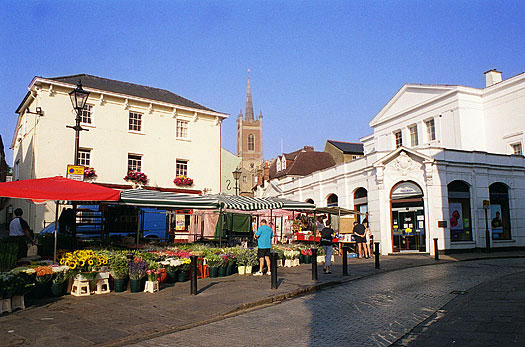 |
|

|
|
 |
|
Guide map includes satellite image of this area
|
|
At the time of the Domesday Book (1086) there were at least fifty recognised markets in England. The actual number was probably far greater but Bishop's Stortford wasn't among them.
Early in the 12th century when the Normans began to rebuild Waytemore Castle the arrival of many stonemasons, labourers and soldiers virtually doubled the town's population at a stroke. And, with the river crossing being the convergence point of seven busy roads, the area saw a dramatic increase in travellers – thus making trade increasingly important.
Establishing a marketplace was often the first stage of a settlement's graduation to 'borough' status. Under Norman rule new markets were created, or recognised, under a licensing system and at the discretion of the King. This was essentially a means of raising revenue for the royal coffers via toll charges and from merchants plying their trade. However, tolls were not excessive and seldom amounted to more than 1% of a trader's profits. Various customs also made certain goods exempt from the toll, most typically those bought for household consumption. Similarly produce from peasant households, such as apples or butter in earthenware pots, was also exempt.
Countrywide, town growth was at its greatest during the reign of Henry III (1207–1272) and Bishop's Stortford's market was in existence by 1228. Bishops, like kings, were never slow at finding ways to increase revenue. And since no record exists of any king granting the town a charter to hold a market, we assume that permission was granted by the Bishop of London – responsible for the Manor of Stortford since the time of the Conquest. That said, it is possible that the market was initially established simultaneously with the rebuilding of the castle.
In the 12th and 13th centuries there was little to distinguish between town and countryside. Fields, crofts and orchards held by residents adjoined the marketplace, and their workshops and stalls surrounded the Market Cross at its centre (its prominent position indicating that it was a public cross, erected by the Bishop as proof that he had granted the town the right to hold a market).
The first mention of the Cross appears in Churchwardens' accounts of 1431, in which it is referred to as Pottershall or Potterscros [sic]. No material evidence of the cross has been found, but local historians conclude that it probably stood at the southern end of the present-day Corn Exchange (currently occupied by the Halifax Bank). In more recent years the remains of a potter's kiln chimney were unearthed here, perhaps explaining why the cross was so named. Potter Street takes its name from Potters Cross.
Weekly markets throughout England were generally held on set days to avoid clashes with similar trade in nearby towns. After 1250 'nearby' was interpreted in law as being a distance of roughly seven miles, but by 1690 the distance had shrunk to approximately three miles. Bishop's Stortford market had little or no 'nearby' competition and then, as now, took place on a Thursday.
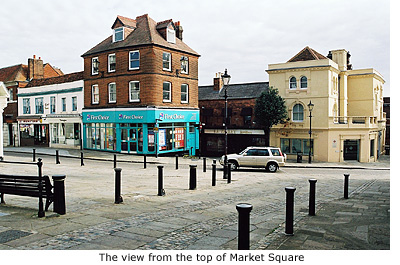 The market was for the sale of surplus produce by townspeople and those from the surrounding area, and for the purchase of necessities and items needed for daily work. As in all market towns, many Stortford occupants employed themselves in the production of a variety of commodities of which the main were victualling, metal working and building – and the making of leather, cloth and shoes. Any peasants able to produce surplus grain or animal products would also have traded at the market.
The market was for the sale of surplus produce by townspeople and those from the surrounding area, and for the purchase of necessities and items needed for daily work. As in all market towns, many Stortford occupants employed themselves in the production of a variety of commodities of which the main were victualling, metal working and building – and the making of leather, cloth and shoes. Any peasants able to produce surplus grain or animal products would also have traded at the market.
The biggest shopping events of the Middle Ages took place at the fairs, which in Stortford were held in the churchyard three times a year: Michaelmas, Ascension and Corpus Christi. At these times, people came from miles around to sell merchandise not usually produced locally.
By the beginning of the 14th century the market was thriving. It stretched east from St Michael’s churchyard along Wheat Hill (now High Street) as far as Dunghill Lane (now Devoils Lane) and to the southernmost boundary of the town, Teynter Hill (now Church Street). Churchwardens' accounts of 1431–1440 also mention a market-house, close to the churchyard, that supported a dilapidated schoolhouse on its timber arches (See the Old Grammar School – Guide 3).
The marketplace was a meeting place for locals and where street performers occasionally entertained the crowds. It was also the most likely site of the town stocks. The square was approached via four short streets, or lanes: Dunghill Lane (now Devoils Lane), Chandlers Row (now Palmer's Lane), Fish Row or Fish Market (now the road behind the Corn Exchange) and South Street.
The name 'Row' stems from the parallel lines of stalls that stood in the marketplace, each separated by a broad throughway. Particular commodities were assigned to particular Rows. The Butchery, or Butchers Row, sold meat while Spicery Row sold a variety of spices (indicating overseas trade). Candles were sold (and possibly made) in Chandlers Row and the Mercery, or Mercery Row specialised in textiles and silk. Metal workers and a forge probably occupied Shop Row.
Produce in the Fish market may have come from nearby ports or from London, but was in the main locally caught freshwater fish. Dunghill Lane leaves little to the imagination, although its later name, Devoils Lane, suggest a French connection – voil being French for lace. Foreign imports probably arrived via London, among them the paper used by St Michael’s churchwardens to write their accounts. There was also Barley Hill and Wheat Hill (now High Street) and, to the south, Poultry Hill (now Potter Street) and Teynter (or Tenter) Hill (now Church Street). This is one of the more interesting names of the medieval market, indicating a probable association with the making and selling of cloth.
Virtually all of the names of these 'Rows' were borne of the Norman Conquest. The French language dominated its English counterpart for some 300 years after 1066, subsequently the combination of Old French and Middle English gave us the Anglo-Norman tongue. Under Norman rule, Old English was demoted – more so perhaps in Stortford and other towns housing a Norman garrison. Latin was still used for sacred and secular purposes, but French dominated authority, law and commerce. It is estimated that some 10,000 French words were colonised, three quarters of which are still in use today.
|
|
Names of French origin, or Old French (OF) are:
Butcher (boucher)
Chandler (Middle English chaundeler (OF Chandeleur or chandelier)
Cordwainer, or shoemaker (OF cordonnier)
Mercer or Mercery (OF mercier and mercerie)
Poultry Hill (poulet)
Teynter Hill (OF teinturier or tainterier, meaning dyer)
Victualler (OF viandier)
Other Anglo-Norman words familiar to the marketplace:
Bargain (bargaine)
Merchant (Middle English merchaunt, OF marcheant)
Money (monai)
Price (pris)
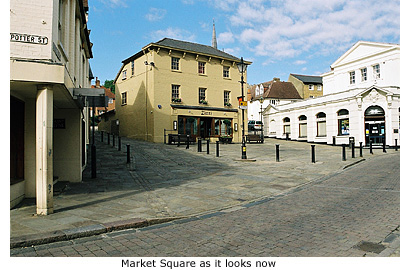 Between the 15th and 19th century the town boasted a thriving leather market – tanneries in Water Lane (See Guide 6) producing the leather for curriers who plyed their trade on the western side of the market square. The dressed and coloured leather was then sold in the leather market which, latterly, was in Poultry Hill (now Potter Street). Between the 15th and 19th century the town boasted a thriving leather market – tanneries in Water Lane (See Guide 6) producing the leather for curriers who plyed their trade on the western side of the market square. The dressed and coloured leather was then sold in the leather market which, latterly, was in Poultry Hill (now Potter Street).
Medieval markets were busy, noisy and dirty places. A variety of odours prevailed as traders carried out their tasks. Dyers vats were particularly noxious when emptied, as was the process of melting animal fat (tallow) by chandlers during the manufacture of candles. Butchers emptied animal waste into the street to rot, dung heaps filled every corner, mud was plentiful and traffic moved slowly. Sanitation was non-existent and open drain channels carried human waste down to the river. Dogs, cats and beggars scavenged for whatever food they could find. Many people kept pigs as a cheap source of food, but the animals often escaped into the streets to roam unfettered.
The raucous cries of traders advertising their wares was countered only by the Town Crier who walked the streets ringing his hand bell declaiming news and proclamations. He was the 'newspaper' of the day, keeping town dwellers informed of local gossip and items of national importance. His cry of "Oyez! Oyez! Oyez!" prefacing every proclamation, descends from the Anglo-Norman oyez or oyer 'to hear' and was a cry for silence and attention.
Before the Reformation, market trading usually began at 6am with the ringing of the Angelus* bell. Trade continued until mid-afternoon, although barbers and blacksmiths may have remained open until the curfew bell sounded at around 8pm or 9pm.
Pedlars and foreign merchants were regulated and had to wait several hours before they could enter the market, so that local traders could benefit from the best business. Saturday was an early closing day, around noon, and Sunday a day of rest – for some. Sunday trading had been banned from 906, although the law was constantly infringed. Henry VI banned the practice again in 1448 – apart from victuallers selling necessary foods.
Constantly seeking ways to make money the Bishop of London and the vicar of St Michael's also rented market stalls to traders. Churchwardens accounts of the 16th century record the following payment: 'to John Monkes 10s [50p] for repairs of the stalls of the church in the mercery and 9d [5p] for repair of stall in butchery with two planks of oak.'
Charges were also made by the church for renting sites to traders – John Threscher of Buntingford paying 28 shillings [£1.40p] per annum for the use of a stall in the butchery.
More revenue came from an early form of parking fees, the vicar of St Michael's charging for the 'stationing of carts on ground of church at times of markets at time of account below 4d'. However, what was gained on the roundabout was sometimes lost on the swings, as a further entry states 'nothing from market stall in fish row because they are not occupied on the market but are filled up with a dung heap'.
In the 15th century the original layout of the medieval market remained intact, although traders' stalls had become permanent structures in the form of timber and plaster-built booths. By Tudor times the flourishing new brick industry, combined with a falling supply of timber, led to an increase in brick buildings and traders' booths evolved into shops and houses while Rows became Streets.
Further enclosure of the market, in particular the square, came in the 1600s with the building of a number of inns, namely the Plume of Feathers, the Reindeer, the Castle, the Dog's Head in the Pot, the Bell and the King's Head. The construction of the latter – originally a tavern but later a large coaching inn with stables and out-buildings – swallowed up many market stalls.
By 1699 the market was in need of regeneration, and preparations were made to build a new market-house and school on the site of the old 16th century Grammar school at the corner of Wheat Hill and Church Street (itself a replacement of the 15th century market-house and school). Completed in 1709, the new structure was of the same design as the old, the ground floor housing market stalls with the school, raised on wooden arches, occupying the building above (See Guide 3). But within fifty years this school also fell into disrepair. Later described as a public nuisance, it was demolished in 1770. It was around this time that the Curriers Arms public house was built, reducing the size of the market square considerably, and a cattle market was established in North Street, also trading on a Thursday (See Guide 7).
The large numbers of inns, victuallers, mercers and shoemakers indicate that Bishops Stortford arose from trade rather than any specific industry, although between the 16th and 19th century the town's prosperity probably owed more to its geographical position than to individual trades. Situated mid-way between London and East Anglia, Stortford became a natural stop-over for travellers and, being at the heart of vast cereal growing lands, benefited greatly from supplying the London market where grain was in constant demand.
Grain trading took place in the aptly named Wheat Hill and Barley Hill (now High Street), but the proximity of the London market saw illegal offers made to local farmers by the 'badgers' or 'loders' who carried goods to the capital. In 1573 Justices of the Peace put an end to 'black market' trading by ensuring that all corn was brought to market, that no deceit was used to raise prices and no one purchased corn for resale. However, the town's greatest return came from barley, used to produce malt for London's breweries. Before 1800, Bishop's Stortford supplied more malt to the capital's brewers of dark porter ale than did any other town in England.
By the early 19th century the grain trade outgrew Wheat Hill and Barley Hill making them unsuitable for trading purposes, and a new venue was sought. Purpose-built Corn Exchanges were springing up in other towns and cities across the land, and in 1828 a business consortium was formed to build such an establishment in Stortford. That same year the King's Head Inn and adjoining buildings were purchased and demolished and the present Corn Exchange erected on the site. Apart from cosmetic changes, the market square remains virtually unchanged from that time.
*Pre-Reformation, the Angelus was prayed three times a day at 6am, noon and 6pm, the commencement of prayer indicated by the ringing of the Angelus bell. No mention is made of this bell in the records of St Michael's, but being a Catholic church at that time, it seems unlikely that it wouldn't have had one. In 1536 Thomas Cromwell banned Angelus bells throughout England.
|
|
|
|
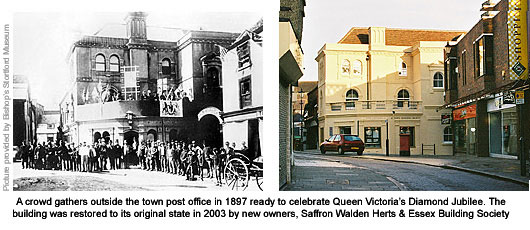 |
|
|
|
At the top of the stone steps that lead from Devoils Lane, stands a small reminder of more recent history in the form of a red telephone box – once commonplace this is now the only example to be found in Bishop’s Stortford.
You now enter Market Square alongside a Grade II listed building that was originally built as the town’s post office (See Guide 1). In more recent years, neglect of the property saw its rapid decline into disrepair, but after purchase by the Saffron Walden Herts & Essex 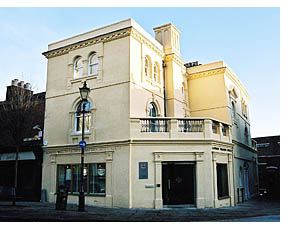 Building Society in 2003 for use as a branch office, and after eight months of restoration and refurbishment work, the exterior of the building now looks very much as it did when first built. Building Society in 2003 for use as a branch office, and after eight months of restoration and refurbishment work, the exterior of the building now looks very much as it did when first built.
In medieval times this same site was very likely occupied by a market stall – one of many in a row of stalls – but in the 17th century the land was secured (possibly by a stall-holder) and a modest timber-framed house built that doubled as a shop or beer house. When the post office was constructed on the site in 1890 the front half of the building continued as a self-contained commercial outlet, and by the turn of the 20th century was occupied by Smith’s the Wine Merchant.
The building itself, with typical round-arched windows and projecting eaves below the roof line, is designed in the Italianate style – a form much favoured by architects of the late Victorian era. Round-arched windows seen above street level were also once a feature of the ground floor, but these were later removed to accommodate a modern shop frontage. An original feature of the building that does remain is the balcony above the shop’s entrance, often used in the past by a select few as an observation platform to watch town celebrations, processions and, sometimes, even royalty pass by below.
Some of the more notable occasions celebrated by townspeople and witnessed from this balcony were: Queen Victoria’s Diamond Jubilee in 1897, the coronation of King Edward VII in 1902 and his subsequent visit to the town in 1906, and the accession of King George V in 1911. MORE PICTURES
|
|
[ BACK TO TOP ] |
|
|
|
|
|
|
|
|
|





 The market was for the sale of surplus produce by townspeople and those from the surrounding area, and for the purchase of necessities and items needed for daily work. As in all market towns, many Stortford occupants employed themselves in the production of a variety of commodities of which the main were victualling, metal working and building – and the making of leather, cloth and shoes. Any peasants able to produce surplus grain or animal products would also have traded at the market.
The market was for the sale of surplus produce by townspeople and those from the surrounding area, and for the purchase of necessities and items needed for daily work. As in all market towns, many Stortford occupants employed themselves in the production of a variety of commodities of which the main were victualling, metal working and building – and the making of leather, cloth and shoes. Any peasants able to produce surplus grain or animal products would also have traded at the market. Between the 15th and 19th century the town boasted a thriving leather market – tanneries in Water Lane (See Guide 6) producing the leather for curriers who plyed their trade on the western side of the market square. The dressed and coloured leather was then sold in the leather market which, latterly, was in Poultry Hill (now Potter Street).
Between the 15th and 19th century the town boasted a thriving leather market – tanneries in Water Lane (See Guide 6) producing the leather for curriers who plyed their trade on the western side of the market square. The dressed and coloured leather was then sold in the leather market which, latterly, was in Poultry Hill (now Potter Street). Building Society in 2003 for use as a branch office, and after eight months of restoration and refurbishment work, the exterior of the building now looks very much as it did when first built.
Building Society in 2003 for use as a branch office, and after eight months of restoration and refurbishment work, the exterior of the building now looks very much as it did when first built.